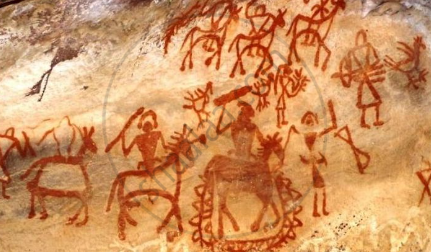Topics
Historiography : Development in the West
History : Applied History
Working of the Constitution
Historiography : Indian Tradition
The Electoral Process
Political Science : Working of the Indian Constitution
Applied History
Political Parties
History of Indian Arts
- What is ‘Art’?
- Indian Traditions of Visual Arts (Drik Kala): Painting
- Prehistoric Paintings
- Mural Paintings and Cave Painting
- Folk Styles of Paintings
- Classical Styles of Painting
- Miniature Paintings in Manuscripts
- Modern Indian Paintings
- Indian Traditions of Visual Arts (Drik Kala): Sculpture Art
- Indus Civilization Sculpture
- Folk Styles of Sculptural Art
- Classical Styles of Sculptural Art
- Indian Iconography
- Indian Traditions of Visual Arts (Drik Kala): Architecture and Sculpture
- Rock-cut Architecture
- Temple Architecture
- Indo-Islamic Architecture
- Indo-Gothic architecture
- Indian Traditions of Performing Arts
- Indian Theatre
- Indian Music
- Indian Dance
- Present Scenario of the Performing Arts
- Art, Applied Art, and Professional Opportunities
Social and Political Movements
- Movement
- Important Movements in India
- Tribal Movement
- Farmers Movement
- Worker's Movements
- Women’s Movement
- Environment Movements
- Consumer Movement
Mass Media and History
Challenges Faced by Indian Democracy
Entertainment and History
Sports and History
Tourism and History
Heritage Management
History - Imperialism
History - 20th Century Age of conflict
History - Emancipation of Asia and Africa
History - World after World War 2
Political Science
Geographical discoveries and colonization
- Concept for Geographical Discoveries and Colonization
Africa
- Imperialism - Africa
Asia: India, China, Japan
- Concept for Asia: India, China, Japan
Dictatorships in Europe, Second World War and world
- Concept on Dictatorships in Europe
- Concept for Second World War and World
First world war
- Concept on First World War
The League of Nations
- Concept for the League of Nations
Russian Revolution
- Concept for Russian Revolution
United Nations Organization
- Concept for United Nations Organization
Africa
- Emancipation of Africa
Asia
- Emancipation of Asia
Globalization
- Globalization After World War II
Scientific and Technological Progress
- Scientific and Technological Progress After World War II
Cold war
- Formation of the Cold War
Social Diversity and Democracy
- Social Diversity
- Coccept for Caste/Race and Democracy
- Concept for Language and Democracy
- Cocnept for Religion and Democracy
- Concept for Gender and Democracy
- Concept for Democracy and Diversity
Challenges to Democracy Remedial Measures to the Challenges
- Concept for Challenges to Democracy Remedial Measures to the Challenges
Internal work
Democracy
- Democracy - Meaning, Types and Characteristics
Political Parties and Types
- Political Parties
- Importance of Political Parties
- Major National and Regional Parties in India/ Types of Political Parties
Notes
Prehistoric Paintings:
|
Prehistoric Painting |
- The term ‘Prehistory’ refers to the many thousand years when there was no existence of paper, language, or any written records in a given culture or society.
- Painting is one of the oldest forms which is practiced by humans to satisfy their aesthetic sensitivity and creative urges.
- Petroglyphs are prehistoric paintings that are typically created in caves on cave rocks.
- Excavations of Prehistoric sites give us fairly accurate knowledge about what happened and how people lived in prehistoric times.
- Prehistoric paintings can be found during the Paleolithic, Mesolithic, and Chalcolithic periods.
- The subjects of their drawings were human figures, human activities, geometric designs, and symbols.
- Prehistoric men's daily lives were frequently depicted in stick-like human figures.
- Ochre is a pigment mineral used as colour.
- Bhimbetka Caves and Narsingarh Caves in Madhya Pradesh, and Jogimara Caves in Chhattisgarh, are a few examples.
1. Bhimbetka Rock Paintings:
|
Group hunting in Bhimbetka Caves in MP |
- It is located south of Bhopal in Madhya Pradesh's Vindhyan ranges, with rock shelters containing over 500 rock paintings.
- V. S. Wakankar discovered the Bhimbetka caves in 1957-58.
- In 2003, it was designated a UNESCO World Heritage Site.
- The oldest paintings are thought to be 30,000 years old and have survived because of their location deep within the caves.
- Bhimbetka's paintings date from the Upper Paleolithic, Mesolithic, Chalcolithic, early historic, and medieval periods. However, the majority of the paintings date from the Mesolithic period.
- The themes of the paintings found here are of great variety. These include hunting, dancing, music, horse and elephant riders, animal fighting, honey collection, decoration of bodies, and other household scenes.
- Elephants, bison, deer, peacocks, and snakes are among the animals depicted.
- Natural resources are used to create colors such as red ochre, purple, brown, white, yellow, and green. For the red color, haematite ores were used, and the white color was most likely derived from limestone. Green made from Chalcedony, a green-colored rock. Plant fiber was used to make the brushes.
If you would like to contribute notes or other learning material, please submit them using the button below.


